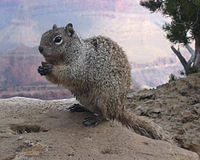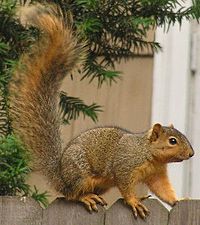Southern flying squirrel: Difference between revisions
Undid revision 240010018 by 71.174.13.243 (talk) |
removed irrelevant information |
||
| Line 37: | Line 37: | ||
{{Commons|Category:Glaucomys volans|Glaucomys volans}} |
{{Commons|Category:Glaucomys volans|Glaucomys volans}} |
||
[[image:J_S_Copley_-_Boy_with_Squirrel.jpg|thumb|left|''G. volans'' has been kept as a pet for many years, as shown in this 1765 painting by [[John Singleton Copley]].]] |
[[image:J_S_Copley_-_Boy_with_Squirrel.jpg|thumb|left|''G. volans'' has been kept as a "pet" for many years, as shown in this 1765 painting by [[John Singleton Copley]].]] |
||
Many wildlife biologists condemn the keeping of wildlife as pets. Many U.S. states have laws in place that make it illegal to capture, sell, or keep native wildlife, and other states require a special permit to do so. It is illegal to keep native wildlife in captivity in Canada without a special permit. |
|||
Exposure to Southern Flying Squirrels has been linked to cases of [[typhus|epidemic typhus]] in humans<ref>[http://www.emedicine.com/med/byname/Typhus.htm eMedicine - Typhus: Article Excerpt by Jason F Okulicz]</ref>. Typhus spread by flying squirrels is known as "sylvatic typhus" and the [[Centers for Disease Control and Prevention]] has documented a total of 39 such cases in the U.S. from 1976 to 2001<ref>[http://www.dsf.health.state.pa.us/health/cwp/view.asp?A=171&Q=249854 Sylvatic Typhus Fact Sheet, Pennsylvania Department of Health]</ref>. The squirrel acts as host to the [[Rickettsia prowazekii]] bacteria and transmission to humans is believed to occur via lice or fleas. |
Exposure to Southern Flying Squirrels has been linked to cases of [[typhus|epidemic typhus]] in humans<ref>[http://www.emedicine.com/med/byname/Typhus.htm eMedicine - Typhus: Article Excerpt by Jason F Okulicz]</ref>. Typhus spread by flying squirrels is known as "sylvatic typhus" and the [[Centers for Disease Control and Prevention]] has documented a total of 39 such cases in the U.S. from 1976 to 2001<ref>[http://www.dsf.health.state.pa.us/health/cwp/view.asp?A=171&Q=249854 Sylvatic Typhus Fact Sheet, Pennsylvania Department of Health]</ref>. The squirrel acts as host to the [[Rickettsia prowazekii]] bacteria and transmission to humans is believed to occur via lice or fleas. |
||
Some believe that if obtained at a young age, Southern Flying Squirrels are easily tamed and can form tight and long-lasting bonds with their owners. The "bonding pouch" method, whereby the owner carries the young squirrel in a bag or pocket every day for several weeks, is often used to nurture this relationship; this allows the squirrel to become familiar with the voice, smell, and heartbeat of its owner, and associate these things with a sense of security. Although more difficult, this method can also be used to bond with an older flyer, but they will often retain more independence than those trained at a young age. Bonded flyers are very social and require a significant commitment in time from their owners. |
|||
Flying squirrels in captivity require a tall, large cage with room to glide. The cage walls should be wire mesh with spacing no larger than 1"x0.5". They should be kept in the dark during the day, due to their nocturnal natures. Flyers can be fed on a commercial bird seed blend supplemented with fresh fruits and vegetables. Hard-shelled nuts should also be provided to prevent overdevelopment of the teeth. Captive flying squirrels are prone to calcium deficiency if fed an improper diet, and this can lead to seizures, [[osteomalacia|rickets]], and an early death. Furthermore, as they are social and nocturnal animals, living without other squirrels or being disturbed during the day may significantly increase their stress levels. |
|||
==Footnotes== |
==Footnotes== |
||
Revision as of 15:32, 9 October 2008
| Southern Flying Squirrel | |
|---|---|

| |
| Scientific classification | |
| Kingdom: | |
| Phylum: | |
| Class: | |
| Infraclass: | |
| Superorder: | |
| Order: | |
| Suborder: | |
| Family: | |
| Subfamily: | |
| Tribe: | |
| Subtribe: | |
| Genus: | |
| Species: | G. volans
|
| Binomial name | |
| Glaucomys volans | |
The Southern Flying Squirrel (Glaucomys volans) is one of two species of the genus Glaucomys, the only flying squirrels found in North America (the other is the somewhat larger Northern Flying Squirrel G. sabrinus). It is found in deciduous and mixed woods in the eastern half of North America, from southeastern Canada, to Florida, USA. Disjunct populations of this species also have been recorded from the highlands of Mexico, Guatemala and Honduras.
Description and ecology

Southern flying squirrels have grey brown fur on top with darker flanks and are a cream color underneath. They have large dark eyes and a flattened tail. They have a furry membrane called a patagium which extends between the front and rear legs, used to glide through the air.
Southern Flying Squirrels feed on fruit/nuts from trees such as red and white oak, hickory and beech. They store food, especially acorns, for winter consumption. They also dine on insects, buds, mushrooms, mycorrhizal fungi, carrion, bird eggs and nestlings and flowers. Predators include snakes[1], owls, hawks and raccoons. Domestic house cats can be dangerous to these animals. Although graceful in flight, they are particularly vulnerable on the ground.
Although the squirrels will make outside nests, especially in pine woods, they prefer to nest in holes in dead trees or snags. They often use these nesting holes communally, especially in winter, when huddling gives them significant energy savings. They readily use artificial nest boxes. They choose holes with smaller entrances than those used by the sympatric Eastern gray squirrel (Sciurus carolinensis). Sometimes they use holes that have been made by woodpeckers such as the Red-cockaded Woodpecker (Picoides borealis); since this is an endangered species, the squirrels are sometimes removed from areas where the woodpeckers nest, though the usefulness of this practice has been disputed. They tend to avoid areas of forest that have been harvested recently.
Both in the wild and in captivity they can produce two litters each year (with 2-7 young per litter), in early spring and mid-summer. The gestation period is approximately 40 days. Young are born without fur or any capabilities of its own. Their ears open at 2 to 6 days old, and fur grows in by 7 days. Their eyes don't open until they are 24-30 days old. Parents leave their young 65 days after they are born. The young then become fully independent at 120 days of age.
Southern Flying Squirrels show substantial homing abilities, and can return to their nests if artificially removed to distances of up to a kilometre. Their home ranges may be up to 40,000 square metres for females and double that for males, tending to be larger at the northern extreme of their range.

Many wildlife biologists condemn the keeping of wildlife as pets. Many U.S. states have laws in place that make it illegal to capture, sell, or keep native wildlife, and other states require a special permit to do so. It is illegal to keep native wildlife in captivity in Canada without a special permit.
Exposure to Southern Flying Squirrels has been linked to cases of epidemic typhus in humans[2]. Typhus spread by flying squirrels is known as "sylvatic typhus" and the Centers for Disease Control and Prevention has documented a total of 39 such cases in the U.S. from 1976 to 2001[3]. The squirrel acts as host to the Rickettsia prowazekii bacteria and transmission to humans is believed to occur via lice or fleas.
Footnotes
- ^ E.g. Elaphe rat snakes, namely Elaphe obsoleta obsoleta: Medlin & Risch (2006)
- ^ eMedicine - Typhus: Article Excerpt by Jason F Okulicz
- ^ Sylvatic Typhus Fact Sheet, Pennsylvania Department of Health
References
- Template:IUCN2006
- Arbogast, B.S. (1999): Mitochondrial DNA phylogeography of the New World flying squirrels (Glaucomys): implications for Pleistocene biogeography. J. Mammal. 80: 142-155.
- Fox, D. & Mulheisen, M. (1999): Animal Diversity Web - Glaucomys volans. Accessed May 20, 2005.
- Fridell, R.A. & Litvaitis, J.A. (1991): Influence of resource distribution and abundance on home-range characteristics of southern flying squirrels. Canadian Journal of Zoology 69: 2589-2593.
- Medlin, E.C. & Risch, T.S. (2006) An experimental test of snake skin use to deter nest predation [English with Spanish abstract]. Condor 108(4): 963-965. DOI:10.1650/0010-5422(2006)108[963:AETOSS]2.0.CO;2 HTML abstract Summary at conservationevidence.com
- Mitchell, L.R.; Carlile, L.D. & Chandler, C.R. (1999): Effects of southern flying squirrels on nest success of red-cockaded woodpeckers. Journal of Wildlife Management 63: 538-545.
- Sawyer, S.L. & Rose, R.K. (1985): Homing in and ecology of the southern flying squirrel Glaucomys volans in southeastern Virginia. American Midland Naturalist 113: 238-244.
- Stapp, P.; Pekins, P.J. & Mautz, W.W. (1991): Winter energy-expenditure and the distribution of southern flying squirrels. Canadian Journal of Zoology 69: 2548-2555.
- Stone, K.D.; Heidt, G.A.; Baltosser, W.H. & Caster, P.T. (1996): Factors affecting nest box use by southern flying squirrels (Glaucomys volans) and gray squirrels (Sciurus carolinensis). American Midland Naturalist 135: 9-13.
- Stone, K.D.; Heidt, G.A.; Caster, P.T. & Kennedy, M.L. (1997): Using geographic information systems to determine home range of the southern flying squirrel (Glaucomys volans). American Midland Naturalist 137: 106-111.
- Taulman, J.F. (1999): Selection of nest trees by southern flying squirrels (Sciuridae: Glaucomys volans) in Arkansas. J. Zool. 248: 369-377.
- Taulman, J.F.; Smith, K.G. & Thill, R.E. (1998): Demographic and behavioral responses of southern flying squirrels to experimental logging in Arkansas. Ecological Applications 8: 1144-1155.
- Thomas, R.B. & Weigl, P.D. (1998). Dynamic foraging behavior in the southern flying squirrel (Glaucomys volans): test of a model. American Midland Naturalist 140: 264-270.
External links
- FlyingSquirrels.com
- National Flying Squirrel Association – Pet squirrel care




